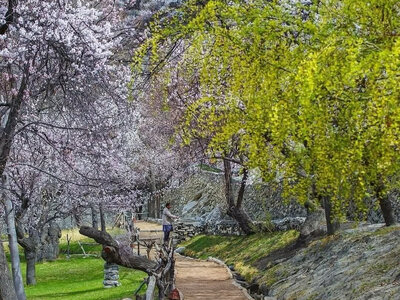
The best time to visit Gilgit Baltistan is from June to September (summer), which is a peak season offering pleasant weather, vibrant meadows & lush green valleys. But the exact best time to visit this breathtaking region depends on what you’re looking for—whether it’s trekking in summer, witnessing cherry blossoms in spring, experiencing the golden hues of autumn, or enjoying snow-covered serenity in winter. Let’s break it down so you can plan your perfect adventure. Better to avoid in the monsoon season due to the rainy season and the danger of landslides on Skardu Road.
The ideal time to visit Gilgit Baltistan is during the summer months, from May to August when the region experiences pleasant weather, vibrant meadows, and lush green valleys. However, the best time for your visit may vary based on your interests. If you’re eager to trek, summer is the ideal time to summit the highest and most difficult peak of Gilgit Baltistan. For those wishing to see the stunning cherry blossoms, spring (March-end to April-mid) is the ideal season. Autumn offers a breathtaking display of golden hues, while winter (December to February) presents a serene landscape blanketed in snow.
The Nagar Valley in Gilgit Baltistan is one of the most stunning destinations globally, a paradise for climbers and trekkers. GB features the world’s highest lake outside the polar region Rush Lake, alongside prominent mountains such as Rakaposhi, Diran Peak, Golden Peak, Hisper Glacier, and Hoper Glacier.
This enchanting time the valley explodes with vibrant colors. Generally occurring from March to early April, this season is characterized by the blooming of cherry, apricot, and almond trees, creating a breathtaking display of pink and white blossoms. The refreshing mountain air, the vivid flowers, and the surrounding snow-capped peaks make this time particularly magical.
It’s a period alive with the scents of flowers, and the locals welcome spring through traditional songs, dances, and festivities. Blossom season is an ideal chance for photography lovers and nature enthusiasts.
This vibrant and beautiful season generally lasts from June to August. During this time, the valley becomes lush and green, with fruit trees heavily laden with cherries, apricots, apples, and walnuts. The climate is pleasantly warm, with temperatures between 15 and 30 degrees Celsius.
The clear blue skies and mild weather provide ideal conditions for trekking, hiking, and exploring the region’s spectacular landscapes, including the famous Rakaposhi and Ultar Sar peaks.
Festivals and traditional celebrations are abundant, giving insight into the traditions and customs of the Hunza community. Whether you seek adventure culture or to enjoy the breathtaking natural beauty, summer is a wonderful time to visit Hunza.